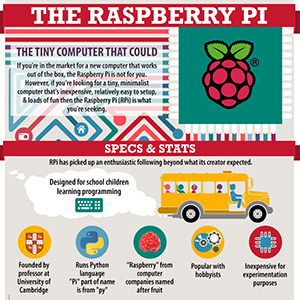
The Raspberry Pi: The Tiny Computer That Could
If you’re in the market for a new computer that works out of the box, the Raspberry Pi might not be to your taste. However, if you’re looking for a tiny, minimalist computer that’s inexpensive, relatively easy to setup, and loads of fun judging by all its educational and hobbyist uses, then maybe the Raspberry Pi, aka RPi, is what you’re seeking.
Raspberry Pi: Facts and Figures
Specs and Stats
In the small handful of years that the Raspberry Pi (aka RPi) has been available, it has picked up an enthusiastic following beyond what its creator expected.
- RPi was meant to run the Python language. The “Pi” part of name is a play on the “py” of Python. The “raspberry” follows a tradition of some computer companies named after fruit.
- Founded by Eben Upton, a professor at University of Cambridge, U.K.
- The idea for the RPi originates in 2006, when incoming students to the Computer Science program at University of Cambridge, U.K., appeared ill-prepared for studies.
- Originally designed for school children learning programming.
- Popular with DIY hobbyists.
- Original sales target was 10K units, total — all of which sold out immediately upon release in Feb 2012, causing months of back orders.
- The one millionth unit sold in within a year’s time.
- The two millionth unit of Raspberry Pi sold some time in Oct 2013, taking less than a year for the 2nd million
- The 2 millionth RPi could have been the one presented to Prince Andrew on Hallowe’en.
- ~40K RPis are produced weekly in Wales. (A early batch was made in China, but operations were move to a Sony-owned manufacturing plant in Wales in Sept 2012.)
- Before Jun 2012, the production rate was just over 200 (204) per week.
- They’re designed to be inexpensive for experimentation purposes.
- The RPi currently runs 6 operating systems, mostly Linux-flavored. These include Pidora, Raspbian (a special version of Debian), Raspberry Pi Education Linux Distro (from learn.adafruit.com; has a child-friendly Web browser) and a few others.
- There are a number of independent companies or individuals selling expansion boards and cases. Some hobbyists have built cases out of special Lego kits.
- Some authorized dealers sell a SD memory card that is preloaded with NOOBS to save users some setup time.
- Footprint is 3 inches by 2 inches — about the shape of a credit card — and 1 inch deep.
- RPi has a system-on-a-chip instead of separate CPU, GPU, USB controller and memory. This allows for the small footprint and the low price.
- Has an SD memory card slot.
- It has 256MB of RAM and a 700MHz ARM-11 processor.
- The Model A ($25) has one USB port and no Ethernet port.
- The Model B ($35) has two USB ports, a 10/100 Ethernet port, HDMI out, 3.5mm audio jack.
- A more powerful Model C may be released, but not likely before 2016-17.
- Plugs in to any HDMI TV.
- It supports 1080p video.
- The graphics card is relatively powerful and can stream video from networked hard drive.
- Supports Apple’s AirPlay audio/ video streaming system.
- It has the graphics power of about the original Xbox — 1 Gpixel per second, 1.5 Gtexels/ sec or 24 GFLOPs of computing power.
- OpenGL 2.0 compliant.
- To setup the RPi Model B, you need an primary computer, an SD card (at least 4GB), HDMI cable (or RCA video lead), HDMI-to-DVI converter (if you’re using a monitor), USB mouse and keyboard, Ethernet cable.
- You need to add extra peripherals for features such as Wi-Fi, or to add the ability to control sensors and motors.
What the Raspberry Pi Can and Cannot Do
For all the things you can do with an RPi (see below), the fact is that it a relatively slow computer, and it does take some effort to setup. It also comes bare, with no accessories, no cables, no case, etc.
- It’s slow — 700 MHz ARM processor — so it’s not meant to replace any other computer you probably have.
- It’s great when you don’t want to experiment with a more expensive computer.
- The RPI is best for hobbyists or as an educational device for aspiring young programmers.
- It has software suitable for children, so makes for an educational PC.
- It can be used for some gaming.
- It’s good for learning to code on. While it’s based on Python , it can run some other programming languages. .Net and Mono (an open source .Net) are some examples.
- It can be overclocked a little bit, from 700Mhz to 900Mhz.
- It’s essentially a full Linux machine.
- It does not run Windows 8 — although one person managed to use an RPi as a conduit between a computer running Microsoft Windows 7 and a 3D printer. However, another hobbyist has also managed to run the now ancient Windows 3.0 on the RPi.
- It’s too slow even for email and Web browsing (that is, if Web pages have complex JavaScript code)
- It can be a Media Center complete with AirPlay.
- Use SiriProxy software to allow Apple’s Siri interface to talk to the RPi. For example, as a garage door opener.
Raspberry Pi Add-Ons
Despite it’s short time on the market, the RPi has a number of available add-on boards from various “Friends of Pi”:
- RPi Camera Board
- RPi Wireless Inventors Kit
- AlaMode, a shield that lets you interface RPi computer and Arduino micro-controllers.
- MTS Smart Power Base — rechargeable lithium battery that also powers Arduino, Netduino, BeagleBone and other boards.
- Pi NoIR Infrared Camera
- PiFace Digital I/O interface — can be used to managed multiple sensors.
- RaZberry for home automation using Z-Wave hardware.
If you need a small computer screen for the RPi, there’s the HDMIPi.
- A Kickstarter campaign for an affordable monitor, the HDMIPi (hdmipi.com), for the RPi met its funding goal of GBP 50K in just 50.5 hours in Nov 2013.
- Funding at the end of the campaign was at GBP 261,250.
- It connects to the RPi via HDMI cable.
- The monitor has a 9 inch (diagonal) screen – slightly smaller than Apple iPad’s 9.7 inch screen.
- The screen resolution is 1280×800 pixels (the same resolution as the original Google Nexus 7, but in a larger physical size).
- Screens of this small typically do not have an HDMI controller without being expensive (due to other types of connectors not needed on the RPi).
- This one costs GBP 65 and requires a bit of assembly.
- The HDMIPi is produced by Alex Eames (RasPi.tv), who is a “Friend of Pi.”
- The HDMIPi can be used for a variety of purposes, including: as a live monitor for a DSLR (Digital SLR) camera or video camera; additional screen for a laptop; mirror screen for a phone or tablet (for app testing); to view DVD or BluRay discs and more.
Uses for the Raspberry Pi
Because of it’s small footprint and uncased nature, the RPi is an incredibly versatile computer. People have used it for an incredible number of purposes, and are discovering new uses regularly. Here are just some of the useful and or fun things you can do with a Raspberry Pi (Model B).
- Arcade game, as a coffee table or in a classic game cabinet.
- Baby monitor (video), via a webcam server setup.
- Beetbox Beatbox — a beatbox musical instrument that is powered by a RPi but interfaces with actual beets. As in the vegetable. Source code at https://github.com/scottgarner/BeetBox.
- Bitcoin miner.
- Beer brewing system.
- Beer can keyboard
- BitTorrent server
- Christmas music and light show
- Cloud server
- Digital camera with touchscreen
- Digital picture frame
- Firefox OS computer (mobile operating system).
- Home automation system, including a lamp timer and other uses. Some setups use the RPi with an Arduino micro-controller or the PiFace add-on board, plus sensors.
- In-dash car computer. There are companies producing out–of-the-box units for some cars. These units are powered with an RPi and come with a touch screen, GPS unit, and a reversing camera at the back of the car. It can interface with a DVD player, MP3/ MPEG4 player, CD, radio and more. It has Bluetooth, which allows you to make calls from the screen via a paired phone. (Shows contact list, not numeric keypad.)
- Landline phone using RPi and Google Voice. (Note: at time of writing, Google intends to close down Voice and integrate it into Google Hangouts.)
- Jukebox / music server. One example is the RasPod, for which there is code on Github.
- Kitchen PC
- Living room PC / media center (XBMC)
- Near-space craft — David Akerman of England attached a weather balloon to a RPi, sending it 40K meters. It sent live video and photos from the upper atmosphere.
- Onboard car computer
- PC, Linux-flavored, by attaching the RPI to the back of a monitor.
- Print server
- Quadcopter drone controller
- RISC OS computer
- Robotics interface.
- Sensor system for humidity and temperature.
- Supercomputer — uses a cluster of RPis linked together. Some people have used Lego for the rack mounting. As many as 64 RPis have been clustered.
- Timelapse dolly controller.
- Timelapse photography with the Raspberry Pi camera board extension.
- Touchscreen tablet. A kit from Chalkboard Electronics includes a 10-inch touchscreen tablet.
- Weather Station, using something like the Maplin USB Wireless Touch Weather Station. The RPi logs all collected data.
- Web browser — hooked up to a TV.
- Web server

References
Information for this article was collected from the following pages and web sites:
- http://www.cnet.com/how-to/25-fun-things-to-do-with-a-raspberry-pi/
- http://www.cnn.com/2012/12/21/tech/innovation/raspberry-pi-computer-upton/
- http://www.engadget.com/2012/09/04/raspberry-pi-getting-started-guide-how-to/
- http://www.hanselman.com/blog/Top10RaspberryPiMythsAndTruths.aspx
- http://makezine.com/magazine/raspberry-pi-101-what-is-the-pi-anyway/
- http://makezine.com/review/eight-great-add-ons-for-your-raspberry-pi/
- http://www.nytimes.com/2013/01/31/technology/personaltech/raspberry-pi-a-computer-tinkerers-dream.html
- http://www.popularmechanics.com/technology/how-to/tips/35-computer-the-vast-possibilities-of-raspberry-pi-15294806
- http://www.raspberrypi.org/phpBB3/viewtopic.php?f=2&t=256
- http://readwrite.com/2014/01/20/raspberry-pi-everything-you-need-to-know
- http://readwrite.com/2014/01/21/raspberry-pi-great-projects
- http://www.theguardian.com/technology/2013/nov/04/raspberry-pi-monitor-hdmipi-kickstarter
- http://www.theguardian.com/technology/2013/nov/18/raspberry-pi-two-million-units-sold-computer-britain

